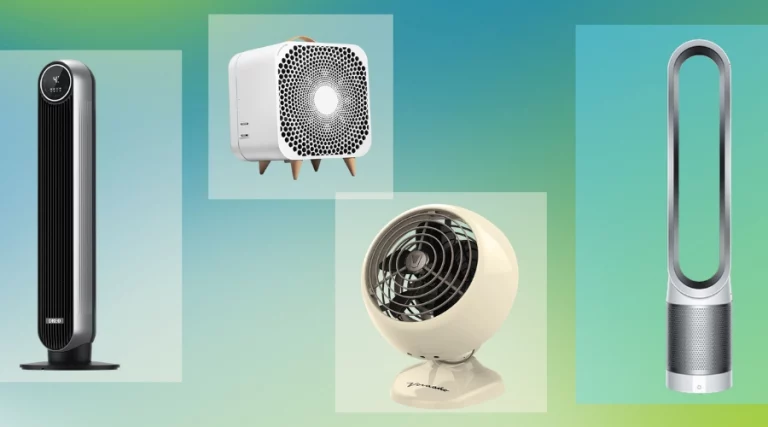In today’s modern world, smart fans are becoming increasingly popular. Smart fans are designed to make life easier and more comfortable by allowing you to control the temperature of your home with ease. Smart fans can be programmed to adjust to your preferences and will help you save money on energy bills. They can also help improve your air quality and reduce allergens, making them a perfect choice for those with allergies or respiratory issues. Smart fans are an innovative way to update your home and make it more comfortable, efficient, and convenient. With a variety of features, you can customize your home to your individual needs. Whether you’re looking for a way to cool down quickly or just want to reduce your energy costs, a smart fan is a perfect solution.
What are Smart Fans?
A smart fan is a device that includes a motorized fan and a remote control or app to operate the fan. It is considered a part of the Internet of Things (IoT) and can be controlled from anywhere using the internet. Smart fans are a great choice for those who want to adjust their fan’s speed and preferences remotely. You can use a smart fan with a thermostat or a stand-alone fan. Some smart fans are also programmable, allowing you to set timers for certain times of the day. One of the most important features of a smart fan is automated climate control. You can use a smart fan to adjust the temperature in your home whenever needed. A smart fan can also be used to keep your home cool in the summer and warm in the winter.
Benefits of Smart Fans
Making your home more energy efficient is one of the many benefits of smart fans. Many smart fans today come with a built-in humidity sensor, which is perfect for keeping your home comfortable when the weather is humid. With a smart fan, you can prevent stuffiness, dry skin, and headaches while reducing your energy bills. Smart fans can also be controlled remotely with your smartphone and are a great way to make your home smarter. Smart fans can be programmed to operate based on weather conditions and your preferred settings. Some smart fans even come with built-in air quality sensors, allowing you to track the air quality in your home and take action if needed. A smart fan can improve your indoor air quality by creating better airflow throughout your home. This can help reduce allergens, especially helpful for those who suffer from certain allergies or respiratory issues.
Features of Smart Fans
- Remote control – Some smart fans offer remote control to operate the fan, making it easier and more convenient to use. A remote control gives you more flexibility in where to place your fan and can be used whether you’re inside or outside your home.
- App control – Many smart fans are designed with an app that you can download on your smartphone to control your fan. This makes it easier to adjust your fan when you’re on the go, and you can even set timers to automatically turn the fan off.
- Humidistat – A humidistat allows you to control the humidity in your home. It is important to maintain the right amount of humidity in your home, especially in the summer when the humidity is high.
- Multiple speeds – A smart fan can control the speed of the fan, allowing you to adjust it to different settings. Some fans even offer different color options for lights and can be set to operate at certain times of the day.
- Remote control for other devices – If you have a smart fan that is linked to other devices in your home, it can also control those devices. This is a great way to make your home smarter and create a more convenient living experience.
How Smart Fans Can Save You Money
A smart fan can help you save money in many ways, including lowering your energy bills and preventing dry skin and headaches.
- Humidistat – As mentioned above, a humidistat allows you to control the humidity in your home. Dry air can cause uncomfortable symptoms such as itchy skin, headaches, and even damage to your furniture. A humidistat can help prevent these issues by adjusting the humidity in your home.
- Multiple speeds – A smart fan can control the speed of the fan, allowing you to adjust it to different settings. By setting the fan to low speed, you can use it to create a gentle breeze in your home without consuming much energy. This is a great way to keep your home cool without using too much energy.
- Remote control for other devices – If you have a smart fan that is linked to other devices in your home, it can also control those devices. This is a great way to save money by controlling your home’s temperature with a single touch.
The Impact of Smart Fans on Air Quality
A smart fan can help improve the air quality in your home by creating better airflow and managing humidity. The air quality in your home can have an impact on your health and can even affect your productivity. Air quality can be affected by many factors, including the weather, activities in the home, and even chemicals in the air. Some symptoms that indicate poor air quality include dry skin, headaches, stuffiness, and a reduced sense of smell. A smart fan can help improve the quality of the air in your home by increasing airflow and managing humidity. This can help reduce the symptoms associated by poor air quality and make your home more comfortable.
Smart Fan Installation and Maintenance
If you’re considering purchasing a smart fan, keep in mind that it may require extra maintenance and wiring. If the fan is programmed to control other devices in your home, it may need a separate circuit, which may cost you extra money. You can also choose to install your smart fan without wiring, but this option may not be as convenient because you won’t be able to program it from your smartphone. Before you decide which type of fan is best for your home, you should consider your energy usage and how much you are willing to spend. There are many smart fans on the market today, so it can be difficult to choose the right one. You should consider your energy usage, the amount of noise the fan makes, and how easy it is to install and program. You should also take the size of your room into consideration and make sure the fan will fit.
Different Types of Smart Fans
- Ceiling – A ceiling fan has a motor attached to a rotating blade that is mounted on a rotating sphere. They are a common type of smart fan and can be found in many homes. If you have a ceiling fan that isn’t connected to an internet-connected device, it can be converted into a smart fan by adding a hub.
- Tower – A tower fan looks like a tall cylinder and can be placed on a table or desk. A tower fan can be used in any room and is perfect for those who don’t want a large fixture in their home.
- Pedestal – A pedestal fan looks like a tall table fan and can be placed on a table or floor. A pedestal fan is designed to circulate air throughout a room and is a great choice for those who want a more powerful fan.
How to Choose the Best Smart Fan
There are many considerations to keep in mind when you’re choosing a smart fan, including the size of your room and energy usage. You should also consider the noise level of the fan, the remote range, and whether it can be controlled through the app.
- Size of the room – You should choose a fan that is the right size for your room. If you have a small room, you don’t need to use a large fan. Likewise, if you have a large room, a small fan won’t be enough.
- Energy usage – You can save money on energy bills by choosing a fan with low wattage.
- Noise level – You should choose a fan that has a fairly quiet noise level so it can be used in any room without disrupting your sleep or work.
Conclusion
Smart fans are a great way to make your home smarter and more convenient. While these fans can cost more than traditional fans, you’ll see that the extra money is worth it for the convenience and comfort it offers. With a smart fan, you can program your preferred settings and make adjustments remotely. A smart fan can improve your indoor air quality and help you save money on energy bills. Whether you’re looking for a ceiling fan or a tower fan, you can find the perfect smart fan for your home.



